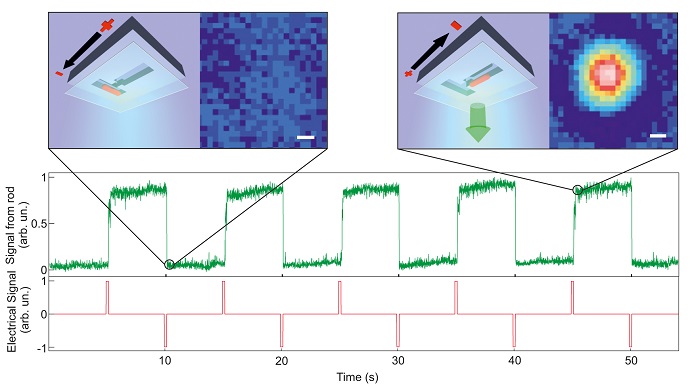August 18, 2015
For the first time ever, researchers have succeeded in creating arrangements of colloids – tiny particles suspended in a solution – and, importantly, they have managed to control their motion with high precision and speed. Thanks to this new technique developed by scientists at the University of Zurich, colloidal nanoparticles may play a role in digital technologies of the future. Nanoparticles can be rapidly displaced, require little energy and their small footprint offers large storage capacity – all these attributes make them well suited to new data storage applications or high-resolution displays.
Colloids are minute particles that are finely distributed throughout a liquid. Suspensions of colloidal particles are most familiar to us as beverages, cosmetics and paints. At a diameter in the range of ten to one hundred nanometres, a single such particle is invisible to the naked eye. These nanoparticles are constantly in motion due to the principle of Brownian motion. Since the particles are electrically charged, they experience forces of attraction and repulsion that can be harnessed to control and manipulate their behavior. In experiments carried out five years ago, Madhavi Krishnan, Professor of Physical Chemistry at the University of Zurich, succeeded in the controlled spatial manipulation of matter on the nanometer scale. In a new study, she and her colleagues have now demonstrated that it is not only possible to spatially confine nanoparticles, but also to control their position and orientation in time and to do so in a liquid, without using physical contact.
Manipulation using electrical and optical signals
The UZH researchers have developed a method that makes it possible to create nanostructures and manipulate them in a flexible way. They were able to organise the tiny particles into new structures with the utmost precision and then to manipulate their motion. «Manipulation is made possible by the interaction with electrical and optical fields», explains Madhavi Krishnan. This new approach using intermolecular interactions at room termperature does not require ultracold temperatures. The new technology also offers extremely fast and low-friction operation.
Smaller, faster and with more storage capacity
This technique for arranging and manipulating colloid motion makes it possible to develop completely new materials and devices. «Nanoparticles possess properties that are very useful for digital technologies, and each individual particle can now be used to store and retrieve data», explains Madhavi Krishnan. The targeted manipulation of individual nanoparticles opens up new options for their application, including in future data storage media or in displays with resolutions that have thus far been hard to attain. «This makes possible displays along the lines of the Kindle reader with a pixel size that is thousand-times smaller and a much faster response time» the scientist explains.
References
Christopher J. Myers, Michele Celebrano and Madhavi Krishnan. Information storage and retrieval in a single levitating colloidal particle. Nature Nanotechnology, August 17, 2015. doi: 10.1038/nnano.2015.173















